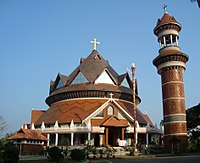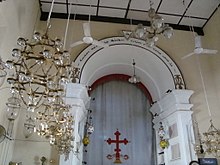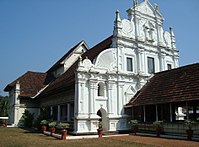Christian denominations in Kerala
There are a large number of Christian churches in India - both indigenous and "offshoots" of Western and Eastern churches. This multiplicity is explained on the one hand from the time of inception frequently to the apostle of local churches, Thomas ( Thomas Christians is returned), the other from the influence of Western churches, especially the Roman Catholic during the colonial period since 1500, as well as the Anglican Church in British colonial times. A number of smaller Reformed churches were added in the past century.
By far the most important part of church history took place in the southern Indian state of Kerala , as the most frequent and closest contacts between India and the West took place here (due to the economic relations that are so active due to the spice trade).
Christians in Kerala
A large percentage of Indian Christians live in the southern state of Kerala : While only around 2.3% of the people in India follow the Christian faith, in Kerala it is around 20%. The reason is that Kerala has historically played a special role - for more than two millennia it has been an area in which the traders of many foreign peoples have their branches and mainly trade in spices. Jewish traders were in Kerala as early as the first centuries BC, and Arab traders have been there for just as long. Later the Christians came to Kerala, from the Middle East countries like Persia , from which they were expelled by the Muslims. The beginning of the Christian era in Kerala is traced back by the Christians themselves to the apostle Thomas; it is said that he converted a number of brahmins to Christianity during his journey through Kerala . The story of these Indian Christians, who today also call themselves “Syrian Christians” according to the region of their main origin.
The main factors
The history of Christians in Kerala has been shaped by three main factors:
- The traditional caste structure of Indian society (which also includes Christians);
- The important function of Kerala as a center of the spice trade for at least 2000 years;
- The influence of the colonial conquerors (Portuguese and British; the Dutch paid little attention to the churches).
The importance of the Indian caste order is already clear from the fact that the Thomas Christians still hold the view that the Apostle Thomas, after his arrival on Indian soil in 52 AD, only converted local Brahmins, whose successors are now the Thomas Christians. This narrative, for which, as for all stories from before about AD 400, there is no evidence whatsoever, even today gives the St. Thomas Christian congregations the feeling of superiority over other Christian congregations, especially over the Latin Christians, who - in part Forcibly converted by the Portuguese - as fishermen belong to the poorest part of society. Even today, many Thomas Christians literally refer to themselves as members of a higher caste, and the associated social differentiations and social stratifications are taken for granted by most members of society as a whole.
Kerala's function as the center of the spice trade plays an important role, as this trade has always led to an influx of traders from the west (Arabia, Rome, Syria) and therefore the religions of these regions have also been present in Kerala. A great many conflicts within the West, for example that between Muslims and Christians and between Christians and Jews, but also between East and West Syrian churches, had their counterparts in Kerala. The influx of Christians from the 7th to 9th century, for example, due to the persecution by the Muslims who invaded all of the Near East, is the historically most likely source of the Thomas Christians (who today all call themselves Syrian Christians ).
The colonization of India by the Portuguese from around 1500 had two immediate consequences for Christianity in India:
- The Portuguese did their best to bring the Thomas Christians, who had their own (presumably East Syrian) rite, under the power of Rome; This only succeeded for a short time, but the Portuguese influence began in 1653 to split the Thomas Christians, the effects of which continue to this day.
- The missionaries converted masses of casteless people , mostly fishermen on the coast, to the Christian faith and accepted them into the Latin Church.
Since that time there has been a contrast between “high-caste” Thomas Christians and “low-caste” Latin Christians. In the 19th century, under the influence of the British, an Anglican-influenced branch of the Thomas Christians, the Mar Thoma Church, split off, and in the 20th century various Reformed and Protestant churches gained influence in India.
Prehistory to around 1660
The following list gives the most important dates for the development of Christians in Kerala up to the time of the oath of the crooked cross in 1653 in Cochin . Shortly thereafter, the time of splits begins, which continues to this day.
| time | What happened | Explanation |
|---|---|---|
| 1st and 2nd BC Century | Jewish traders settle on the Malabar coast. | This is important because the first Christians in Kerala et al. a. come from the Jewish communities already resident there. |
| 52 (ad) | The apostle Thomas comes to India and converts Brahmins to Christianity. | This is the story of the Thomas Christians. There is no evidence. |
| 345 | Immigration of the Knanaya Christians to Kerala | This was the beginning of a mass immigration of Christians of the East Syrian faith. Since this time there have been connections between the Thomas Christians and the East Syrian (Chaldean) Assyrian Church of the East . |
| 1498 | Landing of the Portuguese on the Malabar coast. | Beginning of the conversion of the coastal population to the Latin (Western) Church. Beginning of influencing the Thomas Christians. |
| 1597 | The last bishop appointed by the Patriarch of the Chaldean Catholic Eastern Church, Mar Abraham, dies | Up until this point in time, the Portuguese were still somewhat cautious with the Thomas Christians, who also held the monopoly over the pepper trade. |
| 1599 | Synod of Diamper | Subordination of the Thomas Christians to the Latin Church, "purification" of the rite |
| 1653 | Oath of the crooked cross | Shortly before the collapse of Portuguese supremacy, the Thomas Christians gave up their subordination to the Latin bishops and the Jesuits. A little later there was a break with Rome and a schism, as a result of which the Thomas Christians split into a Catholic and an autocephalic part (the latter split up several times later). |
| 1657 | Return of a large part of the protest party | After Pope Alexander VII sent Italian Carmelites for reconciliation, many Thomas Christians returned from the now autocephalous part to the Roman Church and thus founded today's Syro-Malabar Church , which received Chandy Parambil in 1663 as the first local bishop. Maintaining the traditional East Syrian rite. |
| 1665 | Appointment of Mar Thoma I as bishop of the Thomas Christians who are independent of Rome. | At the request of the Thomas Christians who were independent of Rome, Metropolitan Mar Gregorios from Jerusalem ( Syrian Orthodox Church of Antioch , West Syrian rite) came to India and consecrated Mar Thoma I as bishop, thereby losing the traditional East Syrian rite among the autocephalous Thomas Christians. |
Overview of the church divisions from around 1660
Legend for the "nodes" (a) to (g)
- (a) After the Oath of the Leaning Cross 1653
- (b) 1771 spin-off of the Independent Malabar Church
- (c) from 1865 beginning of the separation of the Mar Thoma Church
- (d) 1888 Own Metropolitan of the Chaldean-Syrian Church
- (e) 1912 spin-off of the autocephalous Malankara Orthodox Syrian Church
- (f) 1934 Under Roman Catholic influence, the Syro-Malankar Church is established
- (g) 1961 The Reformation Evang. St. Thomas Church splits off from the Mar Thoma Church
Legend of the colors
- GREEN : Churches under Anglican influence.
- VIOLET : The two large churches with the West Syrian rite (which were temporarily "reunified" from 1961 to 1975)
- RED : The Roman Catholic Church with three different rites (from top to bottom: West and East Syriac, Latin).
- BLUE : The only church that - like all Thomas Christians before the arrival of the Portuguese - still belongs to the Chaldean Assyrian Church of the East .
Legend for numbering the churches (1) to (9)
The numbers in brackets after the names of the churches refer to the first column of the table below.
List of Christian denominations
The following list of Christian denominations in Kerala is intended to classify the different churches according to origin, affiliation and rite.
| Serial No. | Church name | English name | Important buildings | Membership in millions | Foundation in India | Belongs to | rite | Headquarters in India | head | Remarks |
|---|---|---|---|---|---|---|---|---|---|---|
| 1 | Malankara Orthodox Syrian Church | Indian (Malankara) Orthodox Church | 2.5 | 1912 * Separation from the Malankara Syrian Orthodox Church | independent Indian church | West Syrian Rite | Kottayam, Kerala | Baselios Marthoma Paulose II. | Thomas Christians | |
| 2 | Syro-Malabar Church | Syro-Malabar Catholic Church | 4.0 | 1665 * | unites with the Roman Catholic Church | East Syrian rite | Ernakulam (Cochin, Kochi), Kerala | George Alencherry ( Major Archbishop ) | Thomas Christians | |
| 3 | Malankara Syrian Orthodox Church | Malankara Jacobite Syrian Orthodox Church | 3.5 | 1665 * | “Catholic of India” within the Syrian Orthodox Church of Antioch | West Syrian Rite | Puthencruz near Kochi, Kerala | Mor Baselios Thomas I. | Thomas Christians | |
| 4th | Chaldean-Syrian Church of the East | Chaldean Syrian Church of the East | 0.495 | 1914 | Assyrian Church of the East, exile in Chicago. Chief: Mar Dinkha IV. | East Syrian rite | Trichur, Kerala | Mar Aprem Mooken , Metropolitan of India | Thomas Christians | |
| 5 | St. Thomas Evangelical Church of India | St. Thomas Evangelical Church of India | 0.050 | 1961 * | Tiruvalla, Kerala | Bishop CV Mathew | Thomas Christians; Split from the Mar Thoma Church | |||
| 6th | Mar Thoma Church | Mar Thoma Church , Malankara Mar Thoma Syrian Church | 1.0 | 1889 * | Independent Indian Church | Reformed West Syrian Rite | Tiruvalla , Kerala, India | Joseph Mar Thoma | Thomas Christians; in communion with the Anglican Church | |
| 7th | Independent Syrian Church of Malabar | Malabar Independent Syrian Church (MISC) | 0.010 | 1771 * | independent Indian church | West Syrian | Thozhiyur, Kerala | Metropolitan Cyril Mar Basil I | Thomas Christians; Communion fellowship with the Mar Thoma Church and the Church of England | |
| 8th | Syro-Malankara Catholic Church | Syro-Malankara Catholic Church |

St. John's Cathedral in Tiruvalla, Kerala, South India. New building. The architect of the original 1973 building was Laurie Baker
|
0.530 | 1930 * | unites with the Roman Catholic Church | West Syrian | Thiruvananthapuram (Trivandrum), Kerala | Archbishop Isaac Cleemis Thottunkal | Thomas Christians |
| 9 | Latin Church (Roman Church, Western Church) | Latin Church | 3.5 | 1550 (approx.) | Latin (Roman) Church within the Roman Catholic Church | Latin rite | Verapoly Archdiocese in Ernakulam (Cochin, Kochi), Kerala | Archbishop Rev. Francis Kallarakal | Traditional members: poor fishing population | |
| 10 | Church of South India | Church of South India CSI | 3.8 | 1947 | Union of Anglicans , Congretionalists , Methodists , Presbyterians , | Anglican | Chennai , Tamil Nadu | Moderator: G. Devakadasham | Member of the Anglican Church Fellowship, the World Council of Methodist Churches and the World Reformed Federation. | |
| 11 | Indian Pentecostal Church of God | Indian Pentecostal Church of God | 0.060 | 1924 | No formal liturgy (see Pentecostal worship service ) | Kumbanad, Kerala | Pastor Jacob John | Pentecostalism (Pentecostalism) |
Note: The "*" mark on some dates identifies those churches which trace their foundation to the Apostle Thomas in AD 52.
Overview according to affiliation and rite
In the following table, the churches listed above are classified according to affiliation (vertical) and rite (horizontal). The numbers refer to the numbering in the first column of the previous table. A “-” indicates that the corresponding combination of affiliation and rite cannot occur.
| East Syrian | West Syrian | Latin | Anglic / Reformed | |
|---|---|---|---|---|
| Independently | 1.7 ** (T) | |||
| Eastern Church | 4 (T) | 3 (T) | - | - |
| Roman Catholic | 2 (T) | 8 (T) | 9 | - |
| Anglik./Ref. | 6 * (T) | - | 5 |
Remarks:
- T: Thomas Christians
- 6 *: The Mar Thoma Church is in communion with the Anglican Church.
- 7 **: The Independent Syrian Church of Malabar is in communion with the Mar Thoma Church
literature
- Susan Visvanathan: The Christians of Kerala. History, Belief and Ritual among the Yakoba. 3rd edition, Oxford India Paperbacks, 2003, ISBN 0-19-564799-8 .
- KV Koshi: St. Thomas and the Syrian Churches of India. ISPCK, 1999, ISBN 81-7214-495-4 .
- V. Balakrishnan: History of the Syrian Christians of Kerala (A critical Study). Kerala Publications, Thrissur, 1999.
- Rev. Dr. Marian Arackal and Rev. Dr. Francis Kurisinkal (eds.): Exploring Cochin. Commemoration Volume 450th Anniversary, Diocese of Cochin. Vasco Da Gama Research Institute of Cochin. St. Joseph's Press, Trivandrum 2008.
Web links
The numbering corresponds to that in the two tables above.
- Malankara Orthodox Syrian Church ( Memento from August 22, 2010 in the Internet Archive )
- Syro-Malabar Church
- Malankara Syrian Orthodox Church
- Chaldean-Syrian Church of the East ( Memento from December 24, 2014 in the Internet Archive )
- St Thomas Evangelical Church of India
- Mar Thoma Church
- Independent Syrian Church of Malabar
- Syro-Malankara Catholic Church
- Latin Church
- Church of South India
Individual evidence
- ^ Christian caste. In: Encyclopædia Britannica, 2009, online
- ↑ Susan Visvanathan: The Christians of Kerala. History, Belief and Ritual among the Yakoba. Oxford India Paperbacks, 3rd Edition, 2003. ISBN 0-19-564799-8 , p. 13
- ↑ CJ Fuller: Indian Christians: Pollution and Origins. Man, New Series, Vol. 12, No. 3/4, December 1977, pp. 528-529
- ^ V. Balakrishnan: History of the Syrian Christians of Kerala. A critical study . Kerala Publications, Thrissur 1999, p. 103
- ^ Christian caste . In: Encyclopædia Britannica, 2009, online
- ↑ "The region gained importance through trade with Phenicia, Egypt, Babylon, Arabia, China and the Roman Empire." In: Keralas Frühgeschichte
- ^ V. Balakrishnan: History of the Syrian Christians of Kerala. A critical study . Kerala Publications, Thrissur 1999, p. 95
- ^ KV Koshi: St. Thomas and the Syrian Churches of India. ISPCK, 1999, ISBN 81-7214-495-4 , p. 42
- ↑ The point in time 345 AD is very uncertain; estimates go to AD 900: V. Balakrishnan: History of the Syrian Christians of Kerala. A critical study . Kerala Publications, Thrissur 1999, pp. 87-90
- ↑ Portuguese Colonial History
- ^ Thomas Christians, Colonialism section, last sentence.









